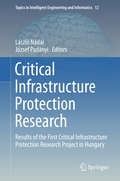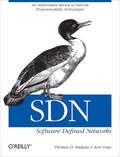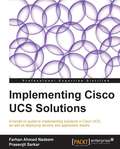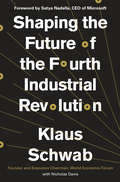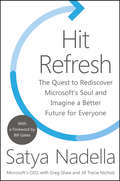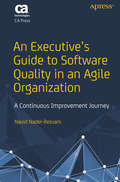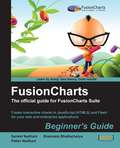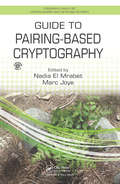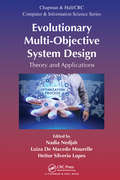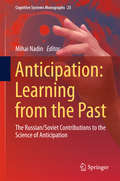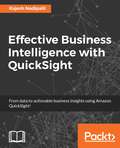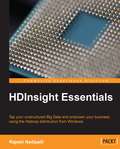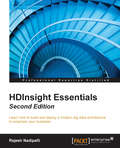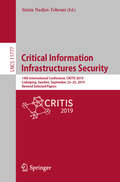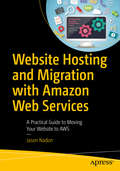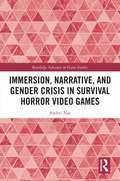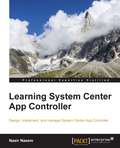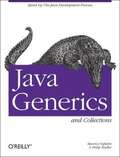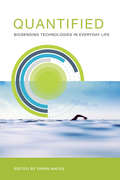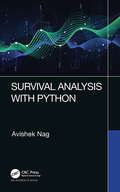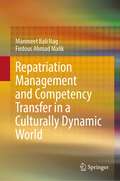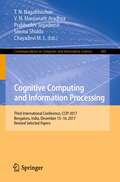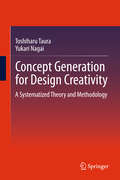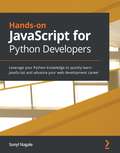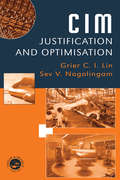- Table View
- List View
Critical Infrastructure Protection Research: Results of the First Critical Infrastructure Protection Research Project in Hungary (Topics in Intelligent Engineering and Informatics #12)
by László Nádai József PadányiThis bookpresents recent research in the recognition of vulnerabilities of nationalsystems and assets which gained special attention for the CriticalInfrastructures in the last two decades. The book concentrates on R&Dactivities in the relation of Critical Infrastructures focusing on enhancingthe performance of services as well as the level of security. The objectives ofthe book are based on a project entitled "Critical InfrastructureProtection Researches" (TÁMOP-4. 2. 1. B-11/2/KMR-2011-0001) whichconcentrated on innovative UAV solutions, robotics, cybersecurity, surfaceengineering, and mechatornics and technologies providing safe operations ofessential assets. This report is summarizing the methodologies and effortstaken to fulfill the goals defined. The project has been performed by theconsortium of the Óbuda University and the National University of PublicService.
SDN: An Authoritative Review of Network Programmability Technologies
by Thomas D. Nadeau Ken GrayExplore the emerging definitions, protocols, and standards for SDN--software-defined, software-driven, programmable networks--with this comprehensive guide. Two senior network engineers show you what's required for building networks that use software for bi-directional communication between applications and the underlying network infrastructure. This vendor-agnostic book also presents several SDN use cases, including bandwidth scheduling and manipulation, input traffic and triggered actions, as well as some interesting use cases around big data, data center overlays, and network-function virtualization. Discover how enterprises and service providers alike are pursuing SDN as it continues to evolve. Explore the current state of the OpenFlow model and centralized network control Delve into distributed and central control, including data plane generation Examine the structure and capabilities of commercial and open source controllers Survey the available technologies for network programmability Trace the modern data center from desktop-centric to highly distributed models Discover new ways to connect instances of network-function virtualization and service chaining Get detailed information on constructing and maintaining an SDN network topology Examine an idealized SDN framework for controllers, applications, and ecosystems
Implementing Cisco UCS Solutions
by Farhan Ahmed Nadeem Prasenjit SarkarA tutorial-based approach which will help you understand the practical methodologies and deploying of Cisco UCS components.If you are a professional such as a system, network, or storage administrator who is responsible for Cisco UCS deployments, this is the perfect book for you. You should have some basic knowledge of the server's architecture, network, and storage technologies. Familiarity with virtualization technologies is also recommended (though not necessary) as the majority of real-world UCS deployments run virtualized loads. Knowledge of Nexus OS is not necessary as the majority of the management tasks are handled in a graphical user interface with very few exceptions using the CLI.
Shaping the Future of the Fourth Industrial Revolution: A Guide To Building A Better World
by Satya Nadella Nicholas Davis Klaus SchwabWorld Economic Forum Founder and Executive Chairman Klaus Schwab offers a practical companion and field guide to his previous book, The Fourth Industrial Revolution.Today, technology is changing everything--how we relate to one another, the way we work, how our economies and goverments function, and even what it means to be human. One need not look hard to see how the incredible advances in artificial intelligence, cryptocurrencies, biotechnologies, and the internet of things are transforming society in unprecedented ways. But the Fourth Industrial Revolution is just beginning, says Schwab. And at a time of such tremendous uncertainty and such rapid change, he argues it's our actions as individuals and leaders that will determine the trajectory our future will take. We all have a responsibility - as citizens, businesses, and institutions - to work with the current of progress, not against it, to build a future that is ethical, inclusive, sustainable and prosperous. Drawing on contributions from 200 top experts in fields ranging from machine learning to geoengineering to nanotechnology, to data ethics, Schwab equips readers with the practical tools to leverage the technologies of the future to leave the world better, safer, and more resilient than we found it.
Hit Refresh: The Quest to Rediscover Microsoft's Soul and Imagine a Better Future for Everyone
by Satya Nadella Greg Shaw Jill Tracie Nichols“At the core, Hit Refresh, is about us humans and the unique quality we call empathy, which will become ever more valuable in a world where the torrent of technology will disrupt the status quo like never before.” – Satya Nadella from Hit Refresh“Satya has charted a course for making the most of the opportunities created by technology while also facing up to the hard questions.” – Bill Gates from the Foreword of Hit Refresh The New York Times bestseller Hit Refresh is about individual change, about the transformation happening inside of Microsoft and the technology that will soon impact all of our lives—the arrival of the most exciting and disruptive wave of technology humankind has experienced: artificial intelligence, mixed reality, and quantum computing. It’s about how people, organizations, and societies can and must transform and “hit refresh” in their persistent quest for new energy, new ideas, and continued relevance and renewal. Microsoft’s CEO tells the inside story of the company’s continuing transformation, tracing his own personal journey from a childhood in India to leading some of the most significant technological changes in the digital era. Satya Nadella explores a fascinating childhood before immigrating to the U.S. and how he learned to lead along the way. He then shares his meditations as a sitting CEO—one who is mostly unknown following the brainy Bill Gates and energetic Steve Ballmer. He tells the inside story of how a company rediscovered its soul—transforming everything from culture to their fiercely competitive landscape and industry partnerships. As much a humanist as engineer and executive, Nadella concludes with his vision for the coming wave of technology and by exploring the potential impact to society and delivering call to action for world leaders. “Ideas excite me,” Nadella explains. “Empathy grounds and centers me.” Hit Refresh is a set of reflections, meditations, and recommendations presented as algorithms from a principled, deliberative leader searching for improvement—for himself, for a storied company, and for society.
An Executive’s Guide to Software Quality in an Agile Organization: A Continuous Improvement Journey
by Navid Nader-RezvaniUtilize a set of practical guidelines to help your Agile organization elevate software design quality as an important business driver to achieve customer satisfaction and, ultimately, higher revenue for your company. This is the first book to focus on a holistic quality view—what it is and how it links to overall business enhancements. The real-world examples used in this book allow you to learn and apply similar strategies and guidelines to help create a quality blueprint for your organization. Five pillars of quality are defined that can be used for any industry and, once internalized, can serve as a set of tools to continuously improve and measure the key factors impacting quality.What You’ll Learn Be aware of the key elements in any transformation that involves culture Link quality and business outcomes Understand quality and its holistic definition and why continuous improvement is still a relevant approach in enhancing quality Follow guidelines with specific examples that can be applied to any product release in any type of industry to improve quality and enhance Agile processes Utilize relevant metrics to measure and continuously improve to make incremental positive changes Who This Book Is For Individuals at various levels in organizations—from Agile scrum teams, all the way up to executive leadership
FusionCharts Beginner’s Guide: The Official Guide for FusionCharts Suite
by Pallav Nadhani Sanket NadhaniThe book is written as a practical, step-by-step guide to using FusionCharts Suite. The book not only teaches you the fundamentals and implementation of FusionCharts Suite, but also makes you the data visualization guru among your friends and colleagues by teaching how to select the right chart type and usability tips. Filled with examples, code samples and practical tips in a no-nonsense way, the book is a breeze to read.This book is both for beginners and advanced web developers who need to create interactive charts for their web applications. No previous knowledge of FusionCharts Suite is assumed, and the book takes you right from downloading it to creating complete reports and dashboards.
Guide to Pairing-Based Cryptography (Chapman & Hall/CRC Cryptography and Network Security Series)
by Nadia El Mrabet; Marc JoyeThis book is devoted to efficient pairing computations and implementations, useful tools for cryptographers working on topics like identity-based cryptography and the simplification of existing protocols like signature schemes. As well as exploring the basic mathematical background of finite fields and elliptic curves, Guide to Pairing-Based Cryptography offers an overview of the most recent developments in optimizations for pairing implementation. Each chapter includes a presentation of the problem it discusses, the mathematical formulation, a discussion of implementation issues, solutions accompanied by code or pseudocode, several numerical results, and references to further reading and notes. Intended as a self-contained handbook, this book is an invaluable resource for computer scientists, applied mathematicians and security professionals interested in cryptography.
Evolutionary Multi-Objective System Design: Theory and Applications (Chapman & Hall/CRC Computer and Information Science Series)
by Nadia Nedjah, Luiza De Macedo Mourelle and Heitor Silverio LopesReal-world engineering problems often require concurrent optimization of several design objectives, which are conflicting in cases. This type of optimization is generally called multi-objective or multi-criterion optimization. The area of research that applies evolutionary methodologies to multi-objective optimization is of special and growing interest. It brings a viable computational solution to many real-world problems. Generally, multi-objective engineering problems do not have a straightforward optimal design. These kinds of problems usually inspire several solutions of equal efficiency, which achieve different trade-offs. Decision makers’ preferences are normally used to select the most adequate design. Such preferences may be dictated before or after the optimization takes place. They may also be introduced interactively at different levels of the optimization process. Multi-objective optimization methods can be subdivided into classical and evolutionary. The classical methods usually aim at a single solution while the evolutionary methods provide a whole set of so-called Pareto-optimal solutions. Evolutionary Multi-Objective System Design: Theory and Applications provides a representation of the state-of-the-art in evolutionary multi-objective optimization research area and related new trends. It reports many innovative designs yielded by the application of such optimization methods. It also presents the application of multi-objective optimization to the following problems: Embrittlement of stainless steel coated electrodes Learning fuzzy rules from imbalanced datasets Combining multi-objective evolutionary algorithms with collective intelligence Fuzzy gain scheduling control Smart placement of roadside units in vehicular networks Combining multi-objective evolutionary algorithms with quasi-simplex local search Design of robust substitution boxes Protein structure prediction problem Core assignment for efficient network-on-chip-based system design
Anticipation: The Russian/Soviet Contributions to the Science of Anticipation (Cognitive Systems Monographs #25)
by Mihai NadinThis volume presents the work of leading scientists from Russia, Georgia, Estonia, Lithuania, Israel and the USA, revealing major insights long unknown to the scientific community. Without any doubt their work will provide a springboard for further research in anticipation. Until recently, Robert Rosen (Anticipatory Systems) and Mihai Nadin (MIND - Anticipation and Chaos) were deemed forerunners in this still new knowledge domain. The distinguished neurobiologist, Steven Rose, pointed to the fact that Soviet neuropsychological theories have not on the whole been well received by Western science. These earlier insights as presented in this volume make an important contribution to the foundation of the science of anticipation. It is shown that the daring hypotheses and rich experimental evidence produced by Bernstein, Beritashvili, Ukhtomsky, Anokhin and Uznadze, among others--extend foundational work to aspects of neuroscience, physiology, motorics, education.
Effective Business Intelligence with QuickSight
by Rajesh NadipalliFrom data to actionable insights using Amazon Quicksight!
HDInsight Essentials
by Rajesh NadipalliThis book is a fast-paced guide full of step-by-step instructions on how to build a multi-node Hadoop cluster on Windows servers.If you are a data architect or developer who wants to understand how to transform your data using open source software, such as MapReduce, Hive, Pig and JavaScript, and also leverage the Windows infrastructure; this book is perfect for you. It is also ideal if you are part of a team who is starting or planning a Hadoop implementation, and you want to understand the key components of Hadoop, and how HDInsight provides added value in administration and reporting.
HDInsight Essentials - Second Edition
by Rajesh NadipalliIf you want to discover one of the latest tools designed to produce stunning Big Data insights, this book features everything you need to get to grips with your data. Whether you are a data architect, developer, or a business strategist, HDInsight adds value in everything from development, administration, and reporting.
Critical Information Infrastructures Security: 14th International Conference, CRITIS 2019, Linköping, Sweden, September 23–25, 2019, Revised Selected Papers (Lecture Notes in Computer Science #11777)
by Simin Nadjm-TehraniThis book constitutes the revised selected papers of the 14th International Conference on Critical Information Infrastructures Security, CRITIS 2019, held in Linköping, Sweden, in September 2019.The 10 full papers and 5 short papers presented were carefully reviewed and selected from 30 submissions. They are grouped in the following topical sections: Invited Papers, Risk Management, Vulnerability Assessment, Resilience and Mitigation Short Papers, and Industry and Practical Experience Reports.
Website Hosting and Migration with Amazon Web Services
by Jason NadonUnderstand the steps necessary to host your website using the Amazon Web Services (AWS) platform. You will be able to set up your website for the first time or migrate your existing website. Explore scenarios, considerations, and steps for three types of websites, including hosting a static website, a content management system (CMS) based website, and a full-featured enterprise level website. Topic areas such as content storage in S3, compute resources in EC2, Route53 DNS Management, email services setup using Simple Email Service as well as strategies for high availability, fault tolerance, and website maintenance are covered. Website Hosting and Migration with Amazon Web Services is organized in a way that allows you to start with simple concepts using AWS core services that allow you to build knowledge and confidence using AWS services while exploring the latest technology on this ever-updating platform. Using AWS to host your website offers you more control over your infrastructure, content delivery, and ability to scale to fit your website needs. It's time to take control and take your website to the next level. This engaging resource: Explains how to use the Amazon Web Services Free Tier to evaluate the platform for hosting your website Walks you through the setup and migration steps for three unique and popular web hosting scenarios Delivers hands-on experience with base concepts that can be built upon to grow and improve your website infrastructure Provides sample resources to test and understand the setup process fully What You'll Learn Evaluate Amazon Web Services (AWS) offered on the platform that may benefit your website Set up and maintain three unique types of websites using AWS core services, enabling you to gain a deeper understanding of what is capable for your website or future projects Select AWS services that can improve performance and control of your website Manage DNS, domain registration, and transfers in AWS Use CloudFront to deliver content efficiently on a global scale Use AWS RDS to deliver a redundant database solution for your website Who This Book Is For Small business owners, webmasters, freelance web designers, and others looking to have more control over their web content, save money by using a platform that charges for just the services you use, or grow the stability of their website by making it highly available, fault tolerant, and easily deployed; those looking to learn more about AWS Web Hosting options in general
Immersion, Narrative, and Gender Crisis in Survival Horror Video Games (Routledge Advances in Game Studies)
by Andrei NaeThis book investigates the narrativity of some of the most popular survival horror video games and the gender politics implicit in their storyworlds. In a thorough analysis of the genre that draws upon detailed comparisons with the mainstream action genre, Andrei Nae places his analysis firmly within a political and social context. In comparing survival horror games to the dominant game design norms of the action genre, the author differentiates between classical and postclassical survival horror games to show how the former reject the norms of the action genre and deliver a critique of the conservative gender politics of action games, while the latter are more heterogeneous in terms of their game design and, implicitly, gender politics. This book will appeal not only to scholars working in game studies, but also to scholars of horror, gender studies, popular culture, visual arts, genre studies and narratology.
Learning System Center App Controller
by Nasir NaeemThis book is intended for IT professionals working with Hyper-V, Azure cloud, VMM, and private cloud technologies who are looking for a quick way to get up and running with System Center 2012 R2 App Controller. To get the most out of this book, you should be familiar with Microsoft Hyper-V technology. Knowledge of Virtual Machine Manager is helpful but not mandatory.
Java Generics and Collections
by Maurice Naftalin Philip WadlerThis comprehensive guide shows you how to master the most important changes to Java since it was first released. Generics and the greatly expanded collection libraries have tremendously increased the power of Java 5 and Java 6. But they have also confused many developers who haven't known how to take advantage of these new features. Java Generics and Collections covers everything from the most basic uses of generics to the strangest corner cases. It teaches you everything you need to know about the collections libraries, so you'll always know which collection is appropriate for any given task, and how to use it. Topics covered include: Fundamentals of generics: type parameters and generic methods Other new features: boxing and unboxing, foreach loops, varargs Subtyping and wildcards Evolution not revolution: generic libraries with legacy clients and generic clients with legacy libraries Generics and reflection Design patterns for generics Sets, Queues, Lists, Maps, and their implementations Concurrent programming and thread safety with collections Performance implications of different collections Generics and the new collection libraries they inspired take Java to a new level. If you want to take your software development practice to a new level, this book is essential reading. Philip Wadler is Professor of Theoretical Computer Science at the University of Edinburgh, where his research focuses on the design of programming languages. He is a co-designer of GJ, work that became the basis for generics in Sun's Java 5.0. Maurice Naftalin is Technical Director at Morningside Light Ltd., a software consultancy in the United Kingdom. He has most recently served as an architect and mentor at NSB Retail Systems plc, and as the leader of the client development team of a major UK government social service system. "A brilliant exposition of generics. By far the best book on the topic, it provides a crystal clear tutorial that starts with the basics and ends leaving the reader with a deep understanding of both the use and design of generics." Gilad Bracha, Java Generics Lead, Sun Microsystems
Quantified: Biosensing Technologies in Everyday Life
by Dawn NafusWhat is at stake socially, culturally, politically, and economically when we routinely use technology to gather information about our bodies and environments? Today anyone can purchase technology that can track, quantify, and measure the body and its environment. Wearable or portable sensors detect heart rates, glucose levels, steps taken, water quality, genomes, and microbiomes, and turn them into electronic data. Is this phenomenon empowering, or a new form of social control? Who volunteers to enumerate bodily experiences, and who is forced to do so? Who interprets the resulting data? How does all this affect the relationship between medical practice and self care, between scientific and lay knowledge? Quantified examines these and other issues that arise when biosensing technologies become part of everyday life.The book offers a range of perspectives, with views from the social sciences, cultural studies, journalism, industry, and the nonprofit world. The contributors consider data, personhood, and the urge to self-quantify; legal, commercial, and medical issues, including privacy, the outsourcing of medical advice, and self-tracking as a “paraclinical” practice; and technical concerns, including interoperability, sociotechnical calibration, alternative views of data, and new space for design.ContributorsMarc Böhlen, Geoffrey C. Bowker, Sophie Day, Anna de Paula Hanika, Deborah Estrin, Brittany Fiore-Gartland, Dana Greenfield, Judith Gregory, Mette Kragh-Furbo, Celia Lury, Adrian Mackenzie, Rajiv Mehta, Maggie Mort, Dawn Nafus, Gina Neff, Helen Nissenbaum, Heather Patterson, Celia Roberts, Jamie Sherman, Alex Taylor, Gary Wolf
Survival Analysis with Python
by Avishek NagSurvival analysis uses statistics to calculate time to failure. Survival Analysis with Python takes a fresh look at this complex subject by explaining how to use the Python programming language to perform this type of analysis. As the subject itself is very mathematical and full of expressions and formulations, the book provides detailed explanations and examines practical implications. The book begins with an overview of the concepts underpinning statistical survival analysis. It then delves into Parametric models with coverage of Concept of maximum likelihood estimate (MLE) of a probability distribution parameter MLE of the survival function Common probability distributions and their analysis Analysis of exponential distribution as a survival function Analysis of Weibull distribution as a survival function Derivation of Gumbel distribution as a survival function from Weibull Non-parametric models including Kaplan–Meier (KM) estimator, a derivation of expression using MLE Fitting KM estimator with an example dataset, Python code and plotting curves Greenwood’s formula and its derivation Models with covariates explaining The concept of time shift and the accelerated failure time (AFT) model Weibull-AFT model and derivation of parameters by MLE Proportional Hazard (PH) model Cox-PH model and Breslow’s method Significance of covariates Selection of covariates The Python lifelines library is used for coding examples. By mapping theory to practical examples featuring datasets, this book is a hands-on tutorial as well as a handy reference.
Repatriation Management and Competency Transfer in a Culturally Dynamic World
by Manmeet Bali Nag Firdous Ahmad MalikThis book examines the relevance of global strategic perspective, as international competition continues to intensify & gain momentum, and management of human resource remains a challenge in contemporary corporate scenario. As global business strategy requires globally competent people and implementation of global human resource systems, therefore the need to harness the multi-faceted dimensions of corporate employees is elaborated upon. This book explores cross cultural movement & interactions in International human resource management, where the theme of cross-cultural reentry remains largely neglected and underestimated in the sojourner’s transition trajectory. This book takes into account the available empirical investigations pointing to substantial concerns, affecting the psychological wellbeing, social readjustment and cultural identity of the returning individuals. This book examines the significance of re-entry as an issue of highest priority to both sojourning individuals as well as people managing the reentry transitions of travelers. In light of the unfolding knowledge revolution, the book explores the context of corporate India offering high knowledge density and rich demographic dividend. The need for companies, to harness the knowledge capital and accelerate Indians in the knowledge revolution is examined. Various factors that can influence the repatriation of an individual when back in the home country, and the challenges faced in repatriation at the individual-, team-, organizational-, and country-levels, is explored & analyzed. This book focuses on eliminating overall wastage and losses in Repatriation process, from an organizational point of view.The purview of this book encompasses the interface of Anticipatory Adjustment, Competency Transfer, Effective Repatriation and Reverse Culture Shock with Repatriates’ Adjustment, back home, and empirically analyzes the precursors and effects of the said paradigms in optimization of Repatriate talent from an organizational perspective. The purpose is to analyze the antecedents of repatriate adjustment in the mentioned context and to subsequently deliberate upon the acquired results to arrive at feasible and relevant conclusions. Optimization of Repatriate talent, and Repatriation Management from International Human Resource Management (IHRM) perspective, deserves a cross-disciplinary study of precursors effecting Repatriation Adjustment, with focus on the dimension of Indian Repatriate acculturation.
Cognitive Computing and Information Processing: Third International Conference, Ccip 2017, Bengaluru, India, December 15-16, 2017, Revised Selected Papers (Communications In Computer And Information Science #801)
by T. N. Nagabhushan V. N. Manjunath Aradhya Prabhudev Jagadeesh Seema Shukla Chayadevi M. L.This book constitutes the refereed proceedings of the Third International Conference on Cognitive Computing and Information Processing, CCIP 2017, held in Bengaluru, India, in December 2017. The 43 revised full papers presented were carefully reviewed and selected from 130 submissions. The papers are organized in topical sections on cognitive computing in medical information processing; cognitive computing and its applications; cognitive computing in video analytics.
Concept Generation for Design Creativity: A Systematized Theory and Methodology
by Yukari Nagai Toshiharu TauraThe concept generation process seems like an intuitional thought: difficult to capture and perform, although everyone is capable of it. It is not an analytical process but a synthetic process which has yet to be clarified. Furthermore, new research methods for investigating the concept generation process--a very difficult task since the concept generation process is driven by inner feelings deeply etched in the mind--are necessary to establish its theory and methodology. Concept Generation for Design Creativity - A Systematized Theory and Methodology presents the concept generation process both theoretically and methodologically. Theoretically, the concept generation process is discussed by comparing metaphor, abduction, and General Design Theory from the notions of similarities and dissimilarities. Analogy, blending, and integration by thematic relation have been explained methodologically. So far, these theories and methods have been discussed independently, and the relations among them have not been clarified. Two newly developed research methods to investigate the concept generation process are clearly explained: the explanation-based protocol analysis and constructive simulation. By reading Concept Generation for Design Creativity - A Systematized Theory and Methodology, students, researchers and lecturers in design disciplines (including engineering design, industrial design, software design, CHI, design education, and cognitive science ) can obtain a clear picture of the advanced research findings and the outline of the theories and methods for concept generation. Furthermore, readers are expected to achieve the competence to generate new concepts.
Hands-on JavaScript for Python Developers: Leverage your Python knowledge to quickly learn JavaScript and advance your web development career
by Sonyl NagaleBuild robust full-stack web applications using two of the world's most popular programming languages Python and JavaScript Key Features Discover similarities and differences between JavaScript and Python coding conventions Explore frontend web concepts, UI/UX techniques, and JavaScript frameworks to enhance your web development skills Put your JS knowledge into practice by developing a full-stack web app with React and Express Book Description Knowledge of Python is a great foundation for learning other languages. This book will help you advance in your software engineering career by leveraging your Python programming skills to learn JavaScript and apply its unique features not only for frontend web development but also for streamlining work on the backend. Starting with the basics of JavaScript, you'll cover its syntax, its use in the browser, and its frameworks and libraries. From working with user interactions and ingesting data from APIs through to creating APIs with Node.js, this book will help you get up and running with JavaScript using hands-on exercises, code snippets, and detailed descriptions of JavaScript implementation and benefits. To understand the use of JavaScript in the backend, you'll explore Node.js and discover how it communicates with databases. As you advance, you'll get to grips with creating your own RESTful APIs and connecting the frontend and backend for holistic full-stack development knowledge. By the end of this Python JavaScript book, you'll have the knowledge you need to write full-fledged web applications from start to finish. You'll have also gained hands-on experience of working through several projects, which will help you advance in your career as a JavaScript developer. What you will learn Discover the differences between Python and JavaScript at both the syntactical and semantical level Become well versed in implementing JavaScript in the frontend as well as the backend Understand the separation of concerns while using Python programming for server-side development Get to grips with frontend web development tasks, including UI/UX design, form validation, animations, and much more Create modern interaction interfaces for your Python web application Explore modern web technologies and libraries for building full-stack applications Who this book is for This book is for experienced Python programmers who are looking to expand their knowledge of frontend and backend web development with JavaScript. An understanding of data types, functions, and scope is necessary to get to grips with the concepts covered in the book. Familiarity with HTML and CSS, Document Object Model (DOM), and Flask or Django will help you to learn JavaScript easily.
CIM Justification and Optimisation
by Sev V NagalingamThis book provides a justification and optimisation model that is complete enough to capture the important features required for a complex decision-making environment for computer integrated manufacturing investment analysis. The model provides facilities to quantify qualitative attributes.
